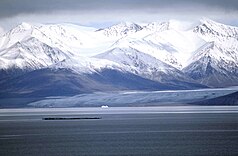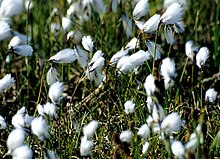Sirmilik National Park
| Sirmilik National Park | ||
|---|---|---|
| Sirmilik glacier | ||
|
|
||
| Location: | Nunavut , Canada | |
| Next city: | Pond inlet | |
| Surface: | 22,200 km² | |
| Founding: | 1999 | |
| Visitors: | 84 (2016/2017) | |
| Address: |
Sirmilik National Park P.O. Box 300 Pond Inlet, Nunavut Tel. (867) 899-8092 |
|
The Sirmilik National Park ( English Sirmilik National Park of Canada , French Parc national du Canada Sirmilik ) includes the Bylot Island and parts of the northern Baffin Island and is around 22,200 square kilometers, the third largest of the more than 40 national parks in Canada . His Inuktitut name means "place of glaciers". The legal requirements for the creation of the national park were met in 1999 and laid down in the Canadian National Park Ordinance of February 19, 2001, after a bird sanctuary had been established on Bylot Island in 1965.
geography
The Sirmilik National Park is geographically divided into three parts
- the Bylot Island ,
- the northeast of the Borden Peninsula
- and an area south of Pond Inlet between Oliver Sound and Paquet Bay.
Bylot Island

On the northeast flank of Bylot Island, the ocean currents of Baffinbai and Lancaster Sound meet and cause the formation of an elongated, three-pointed polynya , a "place where currents do not freeze the sea even in the harshest winters". This Polynja (Lancaster Sound Polynya) extends from Lancastersund around the north and east coast of Bylot Island into Baffinbai and north along the east coast of Devon Island . It is the main reason why the 11,000 square kilometer Bylot Island with its steeply towering rocks on Cape Hay in the northwest on Lancastersund and around Cape Graham Moore in the southeast at the transition from Pond Inlet to Baffinbai has become a bird's paradise and already as a bird sanctuary, which also includes the sea within 3,200 meters, became the most famous region of the national park.
The mountainous central massif of the island of Bylot, which is up to 2,100 meters high and forms part of the Arctic Cordillera , is almost half covered with an ice cap, from which more than 500 mostly unnamed glacier tongues flow down partly to the sea, partly in the lowlands of the island lowlands , and feed countless bodies of water in the summer. The mountain range of the Byam Martin Mountains runs across the island from southeast to northwest . They also include the highest mountain peak on the island, the centrally located Malik Mountain at 2,100 meters. The coasts of the island, especially in the southeast, are predominantly characterized by steep, palisade-like ascending rocks and glaciers migrating towards the sea, but there are also flatter stretches of coastline with many glacial streams, such as sections of the northeast coast, the northwest tip and the presence of hoodoos known southwestern coastal region.
Borden Peninsula
The Borden Peninsula is an extensive plateau with a highest elevation of around 1,380 meters. It is fissured by wide river valleys and has a bird colony on Baillarge Bay.
Oliver Sound
Oliver Sound in the south of Pond Inlet is a long, narrow fjord surrounded by high cliffs and an ice and glacier region of up to 1,650 meters that extends to Paquet Bay.
Climatic conditions
In the north of Baffin Island there is a polar maritime climate, which means long, cold winters and short, cool summers. Spring does not end until mid-June, and the warmest period is late July, early August with average highs of 10 ° C. January as the coldest month has average maximum temperatures of around −30 ° C. Precipitation falls relatively abundantly, which has a positive effect on the flora .
history
By evaluating many archaeological excavation sites, more than 4,000 years of settlement by members of the Dorset and Thule cultures as well as their successors, the Inuit , can be proven for the area of the national park . William Baffin and Robert Bylot advanced to Lancaster Sound in the 17th century . There is also evidence that Eclipse Sound was approached by Europeans in 1820, first by William Edward Parry , one of the more recent explorers of the Arctic. But Scottish and American whalers must have shown up here before him ; in any case, they were often hunting in the surrounding waters during the 19th and early 20th centuries.
In 1906 the Bylot Island was declared part of the Canadian national territory by Captain Joseph Elzéar Bernier. After 1910, Button Point near Cape Graham Moore was a trading post for a few years, the relics of which can still be seen. This area is no longer populated today.
fauna
The Polynya on the northeast flank of the Bylot Island offers arctic birds and marine mammals a special abundance of food and thus makes the national park, but especially the Bylot Island, the spring and summer home of a constant and rich seabird world; for certain species there are even the largest breeding colonies on earth here. If one also includes the migratory movements of many land birds that take place during spring, but especially in June, then the national park is one of the most diverse bird paradises on earth. More than 50 bird species have been observed in the bird sanctuary on Bylot Island, of which at least 30 species breed here.
Bird species
The plains with its tundra in the southwest of the island are home to many species of songbirds , waders and waterfowl (estimated number: more than half a million) in summer . Over 100,000 larger snow geese (Chen caerulescens atlanticus) nest here ; this is the largest snow goose colony with around a third of the world population. The typical arctic bird species turnstone and sandpiped sandpiper also come here, and at least three species of birds commonly found in Europe have been observed here: plover , red knot and wheatear .
The number of thick-billed lumbars nesting on the palisade cliffs is estimated at around 320,000 and that of kittiwakes at over 50,000. The large numbers of species also include black guillemots , northern petrels , king eiders in addition to common eider ducks , common seagulls , ivory gulls , arctic terns , arctic skuas and small crab grebes from the huge colonies of Lancaster Sound.
Fish and marine mammals
As the ice melts, the area of open water expands more and more and offers algae and zooplankton an ideal breeding ground. A variety of fish species benefit from this, including the numerous polar cod and Arctic char . In this way, rich feeding grounds are created - not only for the bird world, but also for various seal species , such as the bearded seal and the ringed seal , which in turn serve as the preferred food for many polar bears ; it is estimated that there are around 150 polar bears on the island in summer. The narwhal , which belongs to the green whales, is also native to these waters . During late summer, more than half of the world's narwhals come to Koluktoo Bay on the edge of Eclipse Sound. In addition, in these waters still others come marine mammals , however, relatively rare for: the white whale , the bowhead whale , the humpback whale and the walrus .
Land mammals
Land mammals in the National Park include caribou , arctic foxes , arctic wolves , ground squirrels and arctic hares .
flora
The heavily glaciated regions of the national park leave only limited space for vegetation. Over time, however, soil crumbs have developed on terminal moraines , lateral moraines , Eskern and other glacier bottoms, so that not only lichens and mosses but also vascular plants could settle in sheltered, ice-free zones facing the sun. This is how plant cushions of stemless ciliates and various saxifrages were created . Grasses , cotton grasses , arctic poppies and white silver arum as well as low shrub species such as dwarf birch , willow family and heather family are also widespread .
As a result of sufficient rainfall, almost all of the Arctic flora thrives in the lowlands and generally in the vicinity of marshlands, puddles and lakes .
Tourist notices
Access to the national park is to the east from Pond Inlet, which is also where the official Parks Canada office is located. In the west, the national park can be reached from Arctic Bay . For tours on skis or with the snowmobile we recommend the time between mid-April and mid-June, for boat and foot tours between the end of July and the end of August.
literature
- Nunavut Handbook, Iqaluit 2004, ISBN 0-9736754-0-3
Web links
- Sirmilik National Park of Canada , on Parks Canada , (English, French)
- Bylot Island (English)
- Sirmilik National Park (English)
- Sirmilik National Park ( English, French ) In: The Canadian Encyclopedia .








